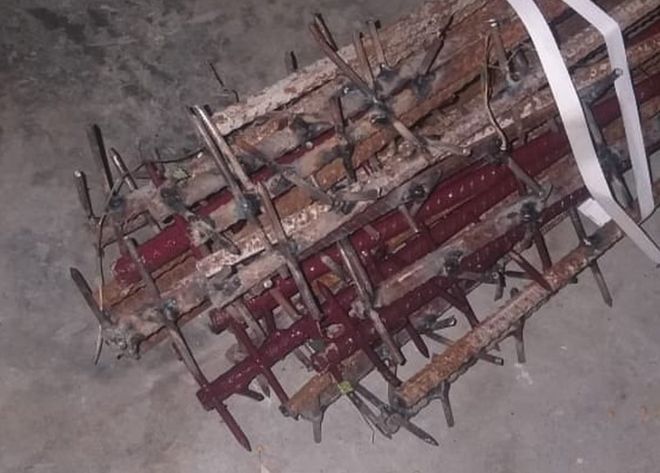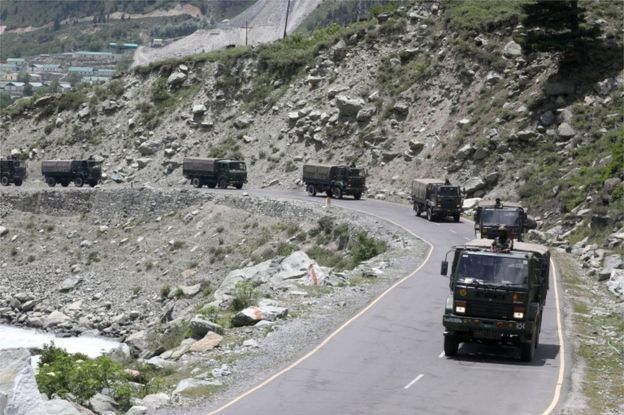Galwan Valley: India rebuts China's land ownership claim

An image passed to the BBC by an Indian military official shows crude weapons purportedly used in the fight
India has rebutted China's ownership claim over the Galwan river valley, the site of the first fatal brawl between the powers in at least 45 years.
A fight on Monday night left at least 20 Indian soldiers dead and escalated tensions between the two nations.
India's foreign ministry said the Chinese claim on the valley was "exaggerated and untenable".
Meanwhile, an image of weapons purportedly used to attack Indian soldiers caused outrage in the country.
The image of the nail-studded iron rods was passed to the BBC by a senior military official on the India-China border, who confirmed its authenticity. The armies of the two countries have not commented on the picture.
Defence analyst Ajai Shukla, who first tweeted the image, described the use of such weapons as "barbarism". The absence of firearms in the clash dates back to a 1996 agreement between the two sides that guns and explosives be prohibited along the disputed stretch of the border, to deter escalation.

Both sides have staged protests over the clashes in the disputed Himalayan border area. China has not released casualty figures. Unconfirmed reports in Indian media say at least 40 Chinese soldiers died. Some Indian soldiers are still believed to be missing.
On Wednesday Beijing quoted a military statement saying China "owns sovereignty over the Galwan Valley region".
Indian foreign ministry spokesperson Anurag Srivastava said the foreign ministers of both countries had a phone conversation on the developments and "agreed that the overall situation should be handled in a responsible manner".
"Making exaggerated and untenable claims is contrary to this understanding," Mr Srivastava was quoted as saying by Press Trust of India news agency.
An Indian government statement after Subrahmanyam Jaishankar's conversation with China's Wang Yi said Beijing tried to erect a structure on the Indian side of the de facto border, the Line of Actual Control (LAC), in the strategically important Galwan Valley.
It described this as "premeditated and planned action that was directly responsible for the resulting violence and casualties" and urged China to "take corrective steps".
Meanwhile, a Chinese statement quoted Mr Wang as saying: "China again expresses strong protest to India and demands the Indian side launches a thorough investigation... and stop all provocative actions to ensure the same things do not happen again."
The Galwan river valley in Ladakh, with its harsh climate and high-altitude terrain, lies along the western sector of the LAC and close to Aksai Chin, a disputed area claimed by India but controlled by China
Media reports said troops clashed on ridges at a height of nearly 14,000 feet along a steep terrain with some soldiers even falling into the fast-flowing, 80km-long (50-mile) Galwan river in sub-zero temperatures.
This is not the first time the two nuclear-armed neighbours have fought without conventional firearms on the border. India and China have a history of face-offs and overlapping territorial claims along the more than 3,440km (2,100 mile), poorly drawn LAC separating the two sides.
The last firing on the border happened in 1975 when four Indian soldiers were killed in a remote pass in the north-eastern state of Arunachal Pradesh. The clash was variously described by former diplomats as an ambush and an accident. But no bullets have been fired since.
At the root of this is a 1996 bilateral agreement that says "neither side shall open fire... conduct blast operations or hunt with guns or explosives within two kilometres of the Line of Actual Control".
But there have been tense confrontations along the border in recent weeks. In May Indian and Chinese soldiers exchanged physical blows on the border at Pangong Lake, also in Ladakh, and in the north-eastern Indian state of Sikkim hundreds of miles to the east.
India has accused China of sending thousands of troops into Ladakh's Galwan Valley and says China occupies 38,000 sq km (14,700 sq miles) of its territory. Several rounds of talks in the last three decades have failed to resolve the boundary disputes.









Comments